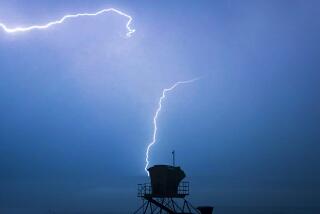Violent Thunderstorms Blamed for 1 Death, Blackout of 50,000 Homes
- Share via
Rare and violent summer thunderstorms continued to rumble across the face of Southern California on Wednesday, blacking out more than 50,000 homes, claiming one life in a traffic accident, and bidding fair to set a new record for rainfall in the month of July.
Southern California Edison Co. spokesman Robert Krauch said that most of the power failures that kept crews scurrying through a day and a night were caused by lightning striking power lines and equipment on a line from northern Orange County through eastern Los Angeles County and into Riverside, San Bernardino and Inyo counties.
“All available personnel have been on the job since Tuesday afternoon,” he said, “and they’ll keep at it until all the lights are on again, but it’s coming so fast that from time to time we get a few paces behind.”
Los Angeles Department of Water and Power spokeswoman Sandra Tanaka said lightning strikes knocked out service to more than 1,500 customers in the harbor and East Los Angeles areas Wednesday, but most circuits were back in operation by nightfall.
Other lightning strikes knocked out the lights at Anaheim Stadium during an Angels game Tuesday night, knocked down trees from Desert Hot Springs to the ocean and injured six farm workers in the Carlsbad area.
None Actually Hit
None of the men was actually struck by the bolt that hit the ground near where they were standing, authorities said, but all were hospitalized for a time when they complained of pains and “tingling” in their extremities. All were reported in good condition Wednesday.
One man was killed when he apparently lost control of his automobile, which hit a curb and rolled over on a rain-slicked roadway in Santa Ana. The driver, identified as Santos Bartolo Esteban, 27, of Santa Ana, was pronounced dead on arrival at a nearby hospital.
A rash of other minor traffic accidents was reported in the wake of the storms, but police and California Highway Patrol officers said there were no other major injuries.
National Weather Service forecasters said the storms, which were caused by an influx of tropical moisture encouraged by a weak area of low pressure that is gradually shifting northward, can543319328so before the entire system drifts away to the north.
Tuesday’s and Wednesday’s storms dropped .18 of an inch of rain at Los Angeles Civic Center--which made this the second-rainiest July on record.
The only July that was wetter, according to the National Weather Service, was back in 1886, when .24 of an inch fell during the month. Other recorded high-water marks were .09 of an inch in 1918, followed by .07 in 1887 and 1898, and .04 in 1910.
Recent years were even drier: The most recently recorded rainfall was a trace that fell in 1971, and .03 of an inch in 1969.
Weather Service statisticians explained that July is normally the driest month of the year in Southern California.
What little rain there is--mostly in the form of scattered thundershowers that are confined to the mountains and deserts--comes as a result of moist, unstable air moving up from the south or southwest--which is just what happened Tuesday night and Wednesday morning. A few mountain locations have recorded five inches or more of July rain in past years, but showers seldom reach coastal or valley areas during the month.
Normal precipitation for July at Los Angeles Civic Center is a flat, unequivocal zero, according to Weather Service statisticians, who based their computations on the three decades from 1951 to 1980.
Wednesday’s high temperature in downtown Los Angeles was 83 degrees, with relative humidity ranging from 51% to 90%. Forecasters said it would be a degree or two warmer today.
More to Read
Sign up for Essential California
The most important California stories and recommendations in your inbox every morning.
You may occasionally receive promotional content from the Los Angeles Times.













